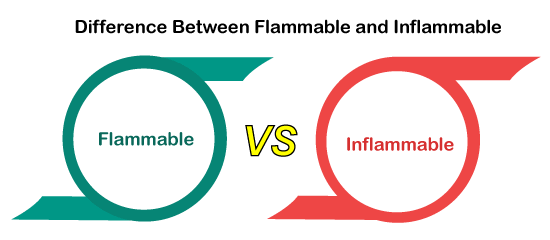Difference between Flammable and InflammableWe have often heard terms like flammable, inflammable, combustion, etc., and have even studied it in our chemistry lectures. But do we really understand what these terms mean? Students are often confused between these terms. Flammable and inflammable might seem to be the same, but they have some basic differences. 
Students might get confused between these two terms because both the terms are associated with flame. So, let us first see the fundamental differences between them.
These are the basic differences between flammable and inflammable substances. Well, some people might think that both words mean the same because they have flame word in them. It might be true because both the terms mean that they can catch fire. The difference lies that flammable substances catch fire easily, and inflammable substances are harder to ignite, i.e., they do not catch fire easily. Well, it interesting to note that in the 1920s, the National Fire Protection Association urged people to use the word 'flammable' instead of 'inflammable.' The main reason for changing the terms was that people might get confused with the term inflammable. They might think that inflammable might mean the things that do not catch fire. That is why the term inflammable was changed to flammable so that the people might not get confused between them. The substances that do not catch fire are called non-flammable substances. For instance, oxygen is a non-flammable substance. It is an oxidizer and does not catch fire. But oxygen can give rise to fire. The fire can be increased with the help of oxygen. The word inflammable has been derived from the Latin word 'inflammare,' wherein 'flammare' means 'to catch fire' and the prefix 'in' means to 'cause to.' The term inflammable was found by a Latin scholar in the year 1813. But when it comes to the difference between flammable and inflammable substances, the only difference between them is how readily the substances catch fire. Out of these two terms, the term flammable is more appropriate and is widely used. On the other hand, inflammable is an older term than flammable because it was coined first. People were advised to use the term flammable to avoid confusion. Well, it is interesting to note that flammable substances are present in solid, liquid, and gaseous states. To determine the flammability of a particular substance, it is important to see some factors on which the flammability depends. Let us look at the factors below:
So, these are the important factors that are required to determine the flammability of a substance. Flammable and inflammable substances mean the same thing. They only differ in one aspect, i.e., the rate at which these substances burn. Flammable substances burn at a faster rate, while inflammable substances ignite gradually. This is the only basic difference between flammable and inflammable substances. Thus, flammable and non-flammable substances are different yet similar to each other.
Next TopicDifference between
|
 For Videos Join Our Youtube Channel: Join Now
For Videos Join Our Youtube Channel: Join Now
Feedback
- Send your Feedback to [email protected]
Help Others, Please Share










